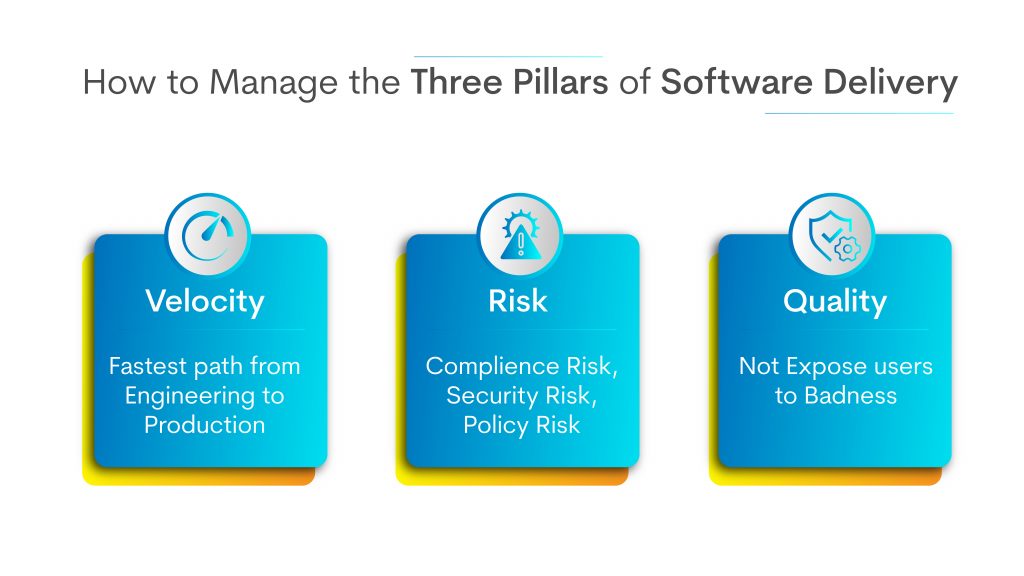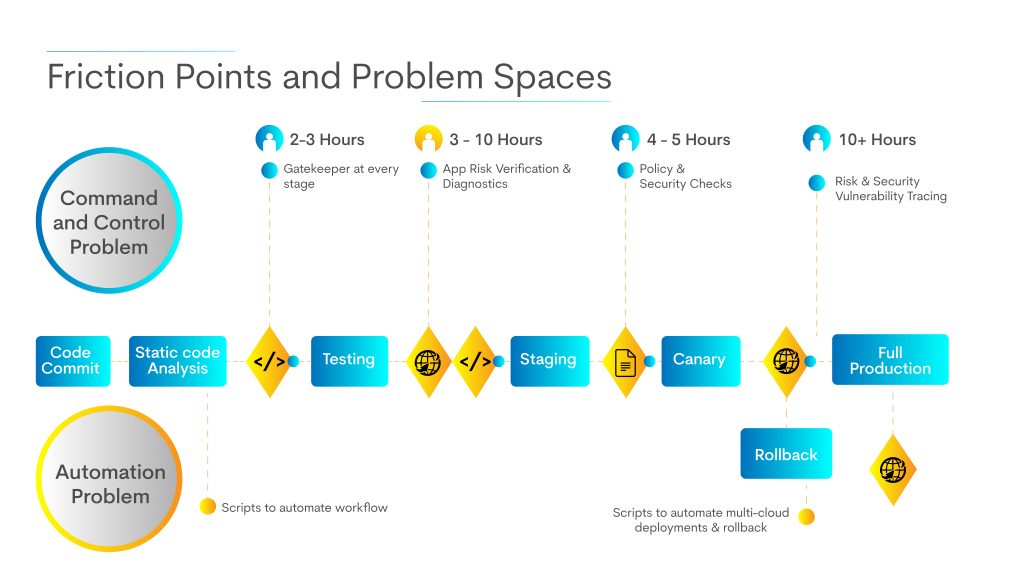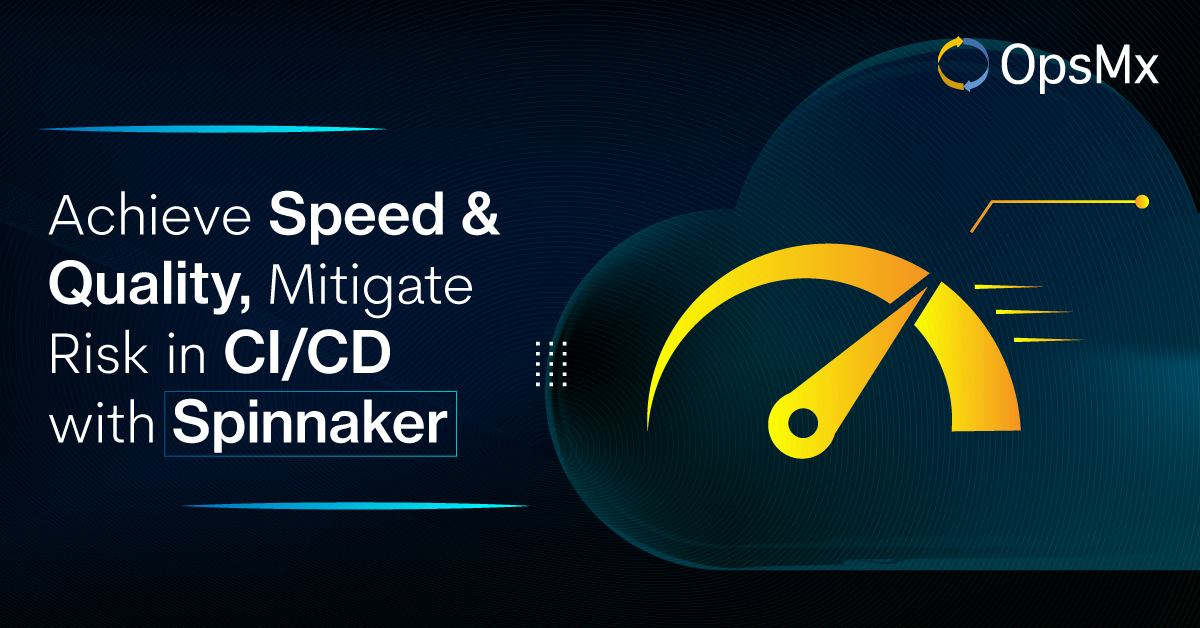Achieve Speed & Quality, Mitigate Risk in CI/CD with Spinnaker
Introduction
If you are in the DevOps or the CI/ CD domain, you might be very familiar with the fact that a smooth execution of software delivery is not without its challenges. We know the pain points very well. Software delivery is about delivering quality software while factoring in underlying risks and speed.
Everyone loves speed. isn’t it? But in the world of software delivery, when you try to attain speed, there might be a trade-off between other important factors. In this blog, we’ll try to convince you that it need not be so, and how you can do it. A win-win scenario is possible. Yes, you can have your cake and eat it too. The latest technological advances in the CI/CD domain make it possible.
The Notion of Three-Legged Tool in CI/CD Process
As described by Robert Boule, Head of Sales Engineering, OpsMx, the CI/CD process has three foundations- he addresses it as the three-legged tool (refer to the image below). The three legs of the CI/CD process are- Speed, Risk, and Quality. Each of the elements is as important as the another to unlock the real value of the CI/CD initiative. Watch this video by Robert Boule.
Just imagine what if one of them is broken? The process will be hampered right? Productivity might suffer. Policy lapses may happen. Licenses might be overlooked. Inconsistencies might crop up. Overall, the entire process of software delivery gets mired in issues. And, you definitely don’t want that to happen.

Three Pillars of Software Delivery
Velocity in CI/CD process
Velocity is the pace at which the software delivery happens. It is the time factored right from the inception of ideas of execution and design in the planning stage to the final deployment in the client’s infrastructure space. That is why it is also known as lead time. Everyone is looking forward to delivering the software in the shortest time possible and clients love it too. But it comes with a caveat.
Risk in CI/CD Process
The risk here refers to the compliance risk, policy risk, and performance risk. This is the most important component of all three factors. Because it is this factor that consumes most of the bandwidth be it in terms of time, budget or effort.
Compliance risk is nothing but ensuring that the company is acting in accordance with its protocols, and adhering to the highest standards of delivering software set by the internal stakeholders. In this way, it can consistently maintain its quality standards so that they don’t have to reinvent the wheel.
And then comes policy risk which is ensuring that the organization is complying with the local and internal government bodies’ rules and regulations. Policy risk factors ensure that all the regulatory data points are being implemented.
Taking these two risks in consideration, the developers have to ensure that the software team delivers applications that have no defects and even if there are, effective rollback strategies are in place for minimizing the performance risk.
Quality in CI/CD Process
Clients expect the software that is being deployed to be working with 100 percent efficacy right from day one. It is not an unrealistic expectation though. After all, you don’t want the hundreds of hours of effort that you have put into unit testing, integration testing, and system testing to go in vain. Because, releasing multiple versions can be such a task, and companies are desperate not to miss the slippages that might happen during delivery.
Friction Points while implementing CI/CD
Though we have witnessed a paradigm shift when it comes to software delivery, the real-world scenarios are far from ideal. Despite our best efforts to integrate all the above-mentioned components of the three legged tool during the delivery, slippages happen and contingencies arise. We see that companies usually have to compromise on at least one among the three when delivering software. Hence, there is a desperate need felt to strike a fine balance between all the three components.
If you try to analyze the root cause of the problems, they can be broadly classified into two types: Automation Problem and Command & Control Problem.
The pictorial representation for the same is explained in the info graphic below.

Friction Points and Problem Spaces
Automation Problem: Just imagine how tedious and time-consuming it would be if you have run scripts (or codes) every time to make deployments in the multi-cloud environments of the clients. There are huge trade-offs that come along with it as it can make the deployment hugely error-prone. Just in case, if a rollback is needed to rectify the errors and make the application up and be running again, the process becomes even more frustrating and onerous because of scripts. To avoid script-based burnouts you need a system in place to orchestrate the CI/CD process.
With automation, you see that most of the repeatable, error-prone processes are eliminated. This makes the rollbacks faster and smarter. This also makes your software delivery process robust and also increases your delivery capabilities by many times.
Command and Control Problem: We realize how hard your team works to deliver quality software that is in sync with global standards. Factoring risk is as important as focusing on velocity and quality. As compromising on the compliance, security, and policy risks can have unintended consequences for both the parties involved.
You want to make sure that the software that you are delivering is adhering to the regulatory standards like GDPR, SOX, HIPAA etc. You definitely don’t want a breach of your confidential data. So mitigating compliance risks is a must. Added to that is the security criteria that needs to be met by the internal stakeholders- developers, product managers, testing team to deal with security risk. After all, you don’t want unauthorized operations spoiling your software release, do you? You need to have gatekeepers at every stage right from the point of committing code, to performing static code analysis to canary testing and ultimately deployment for seamless and accurate software delivery.
Gartner’s analysis on the pace of software delivery
When you tackle the above two friction points, amazing benefits accrue from it. Moreover, the study done by Gartner corroborates this fact. The positive correlation between the error rate and the velocity can be brought down. As per Gartner, an organization can save as much as 2 million dollars, if it can attain speed while mitigating security and compliance risks.
Automation of CI/CD process using Spinnaker
So, if you are keen about bringing down your costs, reducing human intervention and mitigating risks, then we suggest, OpsMx Enterprise for Spinnaker (OES) is the tool for you. It is specifically meant for enterprises who want to pace up their software delivery through the CI/CD methodologies.
OpsMx Enterprise for Spinnaker provides the following capabilities to establish three fundamental pillars of CI/CD:
- Multicloud deployment: Use Spinnaker to deploy applications (containers, VM, or functions) to the public cloud (AWS, GCP, Azure) or private cloud ( like Openshift). Deploy Kubernetes apps seamlessly as Spinnaker treats Kubernetes as a first-class citizen. Read more.
- Automated Pipelines: Automate your release with a flexible pipeline builder in Spinnaker to automate the CI/CD workflow and deliver multi-service composite applications into target environments without writing any scripts. Read more.
- Automated Canary Analysis: Perform automated canary analysis in the Spinnaker pipeline by collecting metrics from monitoring tools. You extend the capability to calculate the risk of any update in each stage of delivery by analyzing build logs, metrics, or test data. Read more
- Security: Embed authentication and authentication by integrating Spinnaker with tools such as OAuth, SAML, LDAP, X.509 certs, Google Groups, Azure Groups, or GitHub Teams. Store your sensitive information using Spinnaker integration with 3rd party secret management tools like Hashicorp Vault. Read more.
- Compliance and Audit: Define and enforce policies into your CI/CD pipeline using OES, and ensure you are 100% compliant to all regulatory standards. Investigate and detect suspicious activities wrt deployments with OES auditing capabilities. Read more.
- Continuous Verification: Decrease risk of software release through AI/ML-based risk assessment using logs and metrics emitted from APM tools. Read more.
Fortune 500 enterprises rely on gaining speed, quality, and mitigate risk in the software delivery process with OpsMx Enterprise for Spinnaker.
If you want to know more about OpsMx Enterprise for Spinnaker or request a demonstration, please book a meeting with us.
OpsMx is a leading provider of Continuous Delivery solutions that help enterprises safely deliver software at scale and without any human intervention. We help engineering teams take the risk and manual effort out of releasing innovations at the speed of modern business. For additional information, contact us.
